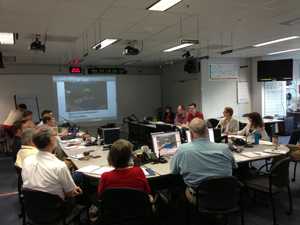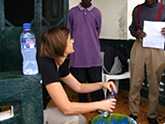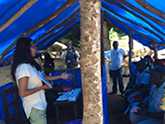Epidemic Intelligence Service Officer Outbreak Investigations

Dr. Julia Painter (CDC; EIS 2013) and Michael Gronostaj (CDC; PMR 2013) with a team investigating a cryptosporiodiosis outbreak in Oregon, 2013
Outbreak investigations result from requests for epidemiological assistance within the United States and throughout the world. Requests to assist with emergency responses, investigate infectious and environmental disease outbreaks, and quantify impact of diseases are examples of these responses. Sometimes these requests come in the form of an “Epi-Aid,” which is a mechanism CDC uses for public health authorities to request short-term epidemiologic assistance.
Our global investigations are conducted in collaboration with international partners, such as ministries of health and the World Health Organization, as well as CDC’s Global Disease Detection and Emergency Response program.
The investigations below were conducted by the Waterborne Disease Prevention Branch’s Epidemic Intelligence Service Officers. The investigations that resulted from an official Epi-Aid request include the Epi-Aid number—the way all Epi-Aids are tracked by CDC. When available, investigations also include articles and information published in the Morbidity and Mortality Weekly Report (MMWR) and on CDC web pages.
Waterborne Disease Prevention Branch Outbreak Investigations
2015
- Outbreak of cholera – Tanzania
- October – December 2015
- Cholera preparedness in the wake of severe flooding – Sierra Leone
- October 2015
- Outbreak of cholera – Kenya
- June – August 2015 (Epi-Aid 2015-028)
- Outbreak of Ebola virus disease – West Africa (Sierra Leone and Mali)
- January – February 2015
- August – September 2015

CDC Epidemic Intelligence Service Officer’s Dr. Rupa Narra (CDC; EIS 2014) and Dr. Kathryn Curran (CDC; EIS 2014), and Dr. Michelle Parsons (CDC) learn about cholera rapid diagnostic test kits in Kenya, 2015.

CDC Epidemic Intelligence Service Officer Dr. Katharine Benedict (CDC; EIS 2015) assists with Ebola prevention efforts in Sierra Leone, 2015.
2014
- Ebola virus disease preparedness training – Cameroon, The Gambia
- November – December 2014
- Ebola virus disease preparedness training – Alabama
- September – October 2014
- Outbreak of Ebola virus disease – West Africa (Liberia, Sierra Leone, Guinea, and Mali)
- July – December 2014
- Outbreak of diarrheal disease of unknown etiology – American Samoa
- June 2014 (Epi-Aid 2014-055)

CDC Epidemic Intelligence Service Officer Dr. Karlyn Beer (CDC; EIS 2014) shows two housekeepers how to mix chlorine in water for proper handwashing to protect against Ebola in Liberia, 2014.

Dr. Julia Painter (CDC; EIS 2013) examines a stool sample while investigating an outbreak of diarrheal illness in American Samoa, 2014.

Dr. Rupa Narra (CDC; EIS 2014) teaches local healthcare workers basic Ebola infection control and prevention measures in a small border health post in Guinea, 2014.
2013
- Public health response to Typhoon Haiyan in the Philippines
- December 2013 (Epi-Aid 2014-024)
- Cryptosporidiosis outbreak, Oregon
- August 2013 (Epi-Aid 2013-072)
2012
- Naegleria fowleri infection – Saint Thomas, U.S. Virgin Islands
- Outbreak of cholera – Sierra Leone
- August 2012 (Epi-Aid 2012-074)
- Outbreak of Guinea Worm Disease – Chad
- April 2012 (Epi-Aid 2012-041)
- Outbreak of typhoid fever – Lusaka, Zambia
- March 2012 (Epi-Aid 2012-034)
2011
- Outbreak of typhoid fever – Harare, Zimbabwe
- Outbreak of typhoid fever characterized by intestinal perforations – Kasese and Bundibugyo Districts, Uganda
- October 2011 (Epi-Aid 2012-009)
- Assessment of cholera mortality at hospitals and cholera treatment centers – Haiti
- August 2011 (Epi-Aid -2011-085)
- Diarrheal incidence in United States healthcare personnel working with cholera patients in Haiti – United States, March-June 2011
- June 2011 (Epi-Aid 2011-044)
- Nationwide persistence of Acanthamoeba keratitis (AK) cases above baseline following an AK outbreak in 2007 – United States, New York
- March 2011 (Epi-Aid 2011-042)
- CDC web page: 2011 Acanthamoeba Keratitis Investigation
2010
- Outbreak of cholera – Haiti
- October 2010 (Epi-Aid 2011-012)—as part of a CDC-wide team working in CDC’s Emergency Operations Center
- Emerging Infectious Diseases: Cholera in Haiti
- MMWR: Update: outbreak of cholera—Haiti, 2010
- MMWR: Update: cholera outbreak—Haiti, 2010
- MMWR: Cholera outbreak—Haiti, October 2010
-
Acanthamoeba keratitis infections among patients referred to Hospital A ophthalmologists – Georgia
- October 2010 (Epi-Aid 2011-08)
- Outbreak of cholera – Cameroon
- September 2010 (Epi-Aid 2010-097)
- Evaluation of the Niger national dracunculiasis eradication program – Niger
- September 2010 (Epi-Aid 2010-096)
- Organ transplant-associated transmission of Balamuthia mandrillaris – Arizona
- September 2010 (Epi-Aid 2010-094)—in conjunction with CDC’s Division of Healthcare Quality Promotion
- MMWR: Notes from the field: Transplant-transmitted Balamuthia mandrillaris—Arizona, 2010
-
Acanthamoeba contamination of corneal transplant tissues from an eye bank – United States
- August 2010 (Epi-Aid 2010-091)—in conjunction with CDC’s Division of Healthcare Quality Promotion
- Health impact and emergency response assessment after disruption of water service – Alabama
- February 2010 (Epi-Aid 2010-039)—in conjunction with CDC’s National Center for Environmental Health
- MMWR: Community health impact of extended loss of water service—Alabama, January 2010
- Transplant-associated transmission of Balamuthia mandrillaris – Mississippi and Kentucky, 2009-2010
- January 2010 (Epi-Aid 2010-034)—in conjunction with CDC’s Division of Healthcare Quality Promotion
- MMWR: Balamuthia mandrillaris transmitted through organ transplantation—Mississippi, 2009
- Page last reviewed: December 18, 2015
- Page last updated: December 18, 2015
- Content source:


 ShareCompartir
ShareCompartir